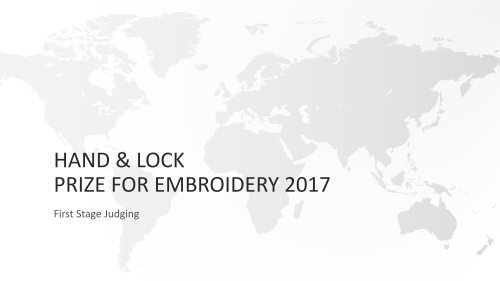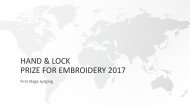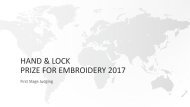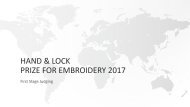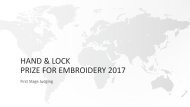Hand Embroidery Textile Art - Student
You also want an ePaper? Increase the reach of your titles
YUMPU automatically turns print PDFs into web optimized ePapers that Google loves.
HAND & LOCK<br />
PRIZE FOR EMBROIDERY 2017<br />
First Stage Judging
C E L E B R A T I O N<br />
C O N T E X T F O R T H E B R I E F<br />
Embroidered textiles have been used across all cultures to celebrate significant life events and successes. Historically, embroidered textiles were<br />
highly valued not only because of their use of precious materials but also the time spent in hand production, particularly within the use of the<br />
technique of goldwork.<br />
Within industry, technological innovations continue to inspire increasingly more varied and intricate textile surfaces and this is visible through the<br />
recent proliferation of digital embroidery on the catwalks. However, this is balanced by a resurgence of interest in maintaining craft skills and<br />
safeguarding this heritage.<br />
In a reaction to throwaway fast-fashion, textile and fashion designers continue to question the sustainability of their practice and explore. Not only<br />
do they reuse and recycle, but exploration of slow textiles and the consideration of the longevity of a project is of growing importance, as is using<br />
their medium draw attention to social issues.<br />
From a wedding dress to highly embellished hip-hop sportswear, to the uniforms of decorated military officers, sequined party dresses and to the<br />
couture of the met gala ball, playful embroidery is an integral part of celebration.<br />
So for 2017 let’s celebrate! Celebrate history, celebrate global culture, celebrate your sense of place, celebrate your sense of identity, celebrate<br />
embroidery and celebrate life.
C E L E B R A T I O N<br />
T H E B R I E F<br />
Of course no CELEBRATION would be complete without an element of FUN and PLAY. This brief asks you to use ‘play’ to celebrate and express your<br />
personal creativity. Explore the balance between tradition and forward thinking, contrasting and embracing both heritage and innovation in a<br />
celebratory and creative way. Create you own response to the desire for the playful and unexpected.<br />
“In a world of austerity and grown up responsibility, we are seeing the increasing desire to let go, to let loose and indulge in childlike freedom or sheer<br />
hedonistic joy… in a turbulent and ever more serious world, there is a craving for silliness and outright frivolity.<br />
People are seeking occasions that allow them to let go of all responsibilities and inhibitions, and embrace outlandish hedonism.”<br />
Barkworth, H. (2014)<br />
http://www.forbes.com/sites/onmarketing/2014/02/04/sixtrendsthatwillshapeconsumerbehaviorthisyear Forbes<br />
This celebration and expression of embroidery in response to the brief will be towards textile art or fashion and may choose to also embrace CAD<br />
machine embroidery within these categories.
TEXTILE ARTS<br />
STUDENT CATEGORY
TEXTILE ARTS<br />
STUDENT CATEGORY<br />
ALISON MYERS
The final brief of the year was called ‘Celebrating Beauty in the Grotesque’. This was set with the <strong>Hand</strong> and Lock competition in mind. I am interested in how death was dealt with in the<br />
past. My research led me to the Egyptian mummies and a book called Heavenly Bodies by Paul Koudounaris, about skeletons found beneath Rome in 16th C and believed to be martyred<br />
saints. I was inspired by the patterns made by the wrappings of the mummies and also intrigued by the mummification of animals, especially cats, to accompany the deceased into the next<br />
life. The Heavenly Bodies book contains amazing images of skeletons dressed in rich textiles and jewels displayed in catholic churches across German speaking Europe. I was inspired by the<br />
grimness of the bones against the beautiful jewels, gold and rich textiles. I used these two themes as inspiration to design my headpiece. The techniques I have used are hat making,<br />
appliqué, laser cutting, bead embroidery, layering, couching and fabric manipulation. The small animal bones I used in the design were ethically sourced from nature.<br />
TEXTILE ARTS<br />
STUDENT CATEGORY<br />
ALISON MYERS
TEXTILE ARTS<br />
STUDENT CATEGORY<br />
ANOUK FRUMENTO
On one hand I have chosen to work with<br />
plastic materials (straws, HAMA beads, woven<br />
tubes). On the other hand I have<br />
experimented with gold work materials. It<br />
appeared to me important to engage with this<br />
family of techniques, and find playful ways to<br />
experiment with it, as it is an important part of<br />
my education, and an essential one of your<br />
institution. As for the plastic materials, it is to<br />
me an interesting way to take the opposing<br />
view of expected embroidery styles. That kind<br />
of materials allow a great variety of texture<br />
and colors that bring into a complete other<br />
univers the world of embroidery.<br />
I also have been interested in the idea of<br />
composition and arrangement. The idea that<br />
the final piece will actually be an association<br />
of several others. Linked to the ‘playful, it lead<br />
to the the principle of the puzzle; the multiple<br />
embroidered elements are in fact magnets<br />
that can be brought together by the observer<br />
in order to create an elaborate patchwork of<br />
textures and colours. The observer becomes<br />
in fact a player, and is free to interact<br />
differently than just with his eyes.<br />
TEXTILE ARTS<br />
STUDENT CATEGORY<br />
ANOUK FRUMENTO
TEXTILE ARTS<br />
STUDENT CATEGORY<br />
ASHLEIGH CHAMBERS
Based on the celebration theme, I would create a boot entirely covered<br />
in goldwork embroidery to look like bursting confetti using bright multicoloured<br />
Purls and Checks on a background of silver goldwork. The<br />
boot will also feature a 3D goldwork fuchsia bow. The giftwrapped shoe<br />
idea was something I created last year as part of my Celebration<br />
project for my footwear degree, which was inspired by Jeff Koons<br />
Celebration series - so when I saw the theme of this years <strong>Hand</strong> &<br />
Lock prize I knew I would love to recreate the gift wrapped shoe<br />
covered in colourful goldwork!<br />
TEXTILE ARTS<br />
STUDENT CATEGORY<br />
ASHLEIGH CHAMBERS
TEXTILE ARTS<br />
STUDENT CATEGORY<br />
CASTELLAR MONTERO
LAMP BASED ON A<br />
SCULPTURE AND AN<br />
EMBROIDERY ON THE TOP. I<br />
HAVE USED SOFT TEXTILE<br />
AND CERAMICS<br />
TEXTILE ARTS<br />
STUDENT CATEGORY<br />
CASTELLAR MONTERO
TEXTILE ARTS<br />
STUDENT CATEGORY<br />
CONNIE NORTON
Heavily influenced by nature and organic mark making my concept is based around the great British garden. Gaining ideas from things such as botanical flowers, wings, pollen,<br />
creatures and things that are in the air. Sustainability is part of the story of this project, which celebrated handcraft and how we value craftsmanship. Some of my imagery comes<br />
from bees, which is also a really important part of my embroidery, as I would like to help honour bees and raise awareness of how vital they are to us. <strong>Embroidery</strong> techniques I have<br />
been using are: French knots, picots, woven circles, princess pleating, quilting, embellishing, beading and I plan on incorporating other techniques and gold work as well.<br />
TEXTILE ARTS<br />
STUDENT CATEGORY<br />
CONNIE NORTON
TEXTILE ARTS<br />
STUDENT CATEGORY<br />
ELENA THORNTON
Cereus is a collection of face and neck adornments created using the traditional technique of Goldwork. Inspired by the Night Blooming Cereus, found on the tropical Island of<br />
Bermuda, this flower blooms for one night a year before perishing by dawn. In celebration of this flower’s short life with it's intriguing beauty and captivating backstory I decided to use<br />
it as the basis of my work. Although it can be found on the vibrant Island of Bermuda, its colour is tame and neutral in appearance. This lent itself beautifully to the technique of<br />
Goldwork. By using padded leather, chipping, cutwork and passing I have been able to create layer and depth within each piece. The final outcomes are delicately detailed with a sense<br />
of celebration for both the technique and the flower, but have a somewhat unforgettable appearance behind it all.<br />
TEXTILE ARTS<br />
STUDENT CATEGORY<br />
ELENA THORNTON
TEXTILE ARTS<br />
STUDENT CATEGORY<br />
EMILY KEYNES
The visual and conceptual focus of my project is the Vulnerability & Fragility present in natural forms, both human and organic. I wish to preserve the delicate<br />
essence of these withering forms in my artwork to celebrate their beauty and worth. I hope to align these qualities in my designs to create a spectacle of<br />
strength through aesthetic weakness, adorning the female form elegantly. I gently manipulate silk fibres, untreated leathers and metal and porcelain<br />
components, to create natural and delicate structures, which mould and extend the body. I braid, wet water mould, machine/irish embroider, cut and gather<br />
my materials to create unique and long lasting pieces.<br />
TEXTILE ARTS<br />
STUDENT CATEGORY<br />
EMILY KEYNES
TEXTILE ARTS<br />
STUDENT CATEGORY<br />
EMMA GUEST
Within a previous project I have looked into the development of drawing, instigating a personal inspiration from the frivolity and innocence of children’s art work. Many lack the<br />
harsh self-critique and desire for realism, leaving more room for imagination and creativity. I decided to focus on the words given in the 2017 brief; ‘Fun’, ‘Play’ and ‘Celebrate’.<br />
Represented by children and the joy and development within their art, celebrating the creativity, free spirit and escapism art can provide individuals. Being inspired by Play<br />
Parks, Indoor Soft Play areas, examples of children’s own drawings and level of stitch technique I drew initial research and primary imagery. I craved to be inspired by areas that<br />
gave joy and represented the words well; including party /celebration themed instillations to draw inspiration from interesting colours and line. Through observational drawings<br />
and leading drawing/basic stitch workshops within a primary school <strong>Art</strong> club I developed my research and ideas. From this I used hand stitch to represent lines, shapes and<br />
textures. I enjoy experimenting with mixed media material within my work using traditional stitch/textiles techniques. Alongside exaggerating basic stitch to celebrate the finer<br />
detail created within the techniques, enhancing interesting the textures and patterns.<br />
TEXTILE ARTS<br />
STUDENT CATEGORY<br />
EMMA GUEST
TEXTILE ARTS<br />
STUDENT CATEGORY<br />
EMMA KIRBY
A desire for the unexpected is a collection of fashion fabrics incorporating bold accents of tropical vibrancies with manipulated embellishments to capture the unpredictable effects of<br />
nature in the Amazon rainforest. Designed for Spring Summer 2018, these innovative printed and embroidered fabrics explore the hidden depths and layers of this unique environment.<br />
The aim was to create a collection of textile designs for a daywear women’s collection with an eccentric colour palette and multimedia approach, captured in the multidisciplinary<br />
approach of processes and materials. The embroidered samples and final piece is a celebration of all things tropical, a festival of nature at its most vibrant. Inspiration was taken from<br />
tropical palm houses to engage with the layers and depths of the Amazon Rainforest. The overlapping of large scale leaves with an abundance of brightly coloured florals were the main<br />
focus of my inspiration as well as the exotic explosion of three dimensional flowers and pattern within pattern.<br />
TEXTILE ARTS<br />
STUDENT CATEGORY<br />
EMMA KIRBY
TEXTILE ARTS<br />
STUDENT CATEGORY<br />
FAYE ARGUELLES
These designs embody a celebration of my ethnicity and making it more of my own from my perspective viewpoint as an individual. The sample are created from<br />
observing traditional embroidery in the Philippines. It also utilizes some plastic waste materials to recreate the beauty that is being destroyed in the ocean; from drawings<br />
of corals, shells and sea nature imageries.The colours represent the richness and importance of our natural resources and that we shouldn’t be taking anything from<br />
granted. I illustrated my samples as headpieces as I feel that it brings more attraction to the body; implementing the significance of showing awareness of these<br />
environmental issues. The placements are influenced by the Ifugao Tribe in the Philippines, where both women and men share work on creating their headdresses. This<br />
“unity of people” is what I would like to show to my audienc, that everything can be restored and even make it better as long as we share and connect together.<br />
TEXTILE ARTS<br />
STUDENT CATEGORY<br />
FAYE ARGUELLES
TEXTILE ARTS<br />
STUDENT CATEGORY<br />
HANNAH SODERGREN
Celebration of Life<br />
Rarely is death associated with celebration. It is generally a sad subject, burdened with sadness and loss. However, if we look to nature, we find that oftentimes<br />
death leaves behind beauty. Bleached corals, the exoskeletons of insects, and preserved flowers are lovely reminders of life that once was. Rather than focus<br />
on what no longer exists, it is possible to hold on to the memories that are left behind. In this way, the burden of loss can be relieved by the celebration of life.<br />
In my piece I have employed beadwork, surface embroidery, and stumpwork. The color palette is only white, to elicit the memory of color and life, while<br />
acknowledging that something important has been lost. The light that the beads catch and reflect help to add contrast and shadow to the piece, and the<br />
stumpwork creates dimension. I created my piece as a collar, to represent the physical weight both loss and remembrance can bear.<br />
TEXTILE ARTS<br />
STUDENT CATEGORY<br />
HANNAH SODERGREN
TEXTILE ARTS<br />
STUDENT CATEGORY<br />
HOLLY MARKHAM
My <strong>Embroidery</strong> explores the narrative of a worker's craft by experimenting with techniques of metal casting, creating handmade laser cut buttons and intricate metal pieces<br />
combining embroidery crafts, juxtaposing modern ways of utilising embroidery techniques.<br />
The techniques that have been used are handmade pewter pieces, some have been originally laser cut and engraved then cast into metal. Other pieces are created from a<br />
clay putty. I have explored techniques of macrame in particular Scandinavian that has been wrapped around plastic tubing a laser cut acrylic circles.<br />
I have used some pearl work over the tubing to attach it onto the fabric, as well as appliqué to attach threads and princess braid cord down.<br />
There are clear acrylic buttons and jigsaw pieces that have been laser cut and appliquéd on.<br />
Everything has been made by hand to celebrate a workers craft and a practitioners art.<br />
TEXTILE ARTS<br />
STUDENT CATEGORY<br />
HOLLY MARKHAM
TEXTILE ARTS<br />
STUDENT CATEGORY<br />
MADELINE WHALLEY
Introducing Granny’s Overgrown Garden, a new textiles collection. My Spring/Summer 2018 Collection shouts Maximalism! I have taken a contemporary approach to exploring the themes<br />
of Kitsch and Nostalgia, through a combination of digital and machine embroidery onto printed design textiles. Exploring the rising trend of Maximalism through the use of materials,<br />
embroidery and embellishment. Celebrating nature through a 'more is more' approach. Granny’s Overgrown Garden takes inspiration from personal memories of my visiting Grandmothers<br />
overgrown garden as a child, to me this Garden was its very own way - Maximalist! Focusing of the creepy crawlies and eccentricity of plants, I have interpreted my theme through<br />
exploring Maximalist design. My textile designs create an escapism from the mundane creatures and nature we see in everyday life to an out-of- this-world secret garden, with the<br />
combination colour and material and the use of innovative embellishment.<br />
TEXTILE ARTS<br />
STUDENT CATEGORY<br />
MADELINE WHALLEY
TEXTILE ARTS<br />
STUDENT CATEGORY<br />
MARY O’SULLIVAN
The concept behind this neck piece was to examine how people<br />
now communicate through social media and what these types of<br />
people are obsessed with, namely; Kim Kardashian, sex, Calvin<br />
Klein sports bras and the newest Apple product. I chose to work<br />
with denim because of it's universal appeal and used bright colours<br />
to mimic the brightness of an Iphone. . I also employed techniques<br />
such as satin stitches, long & short stitches, back stitches, and<br />
beading to illustrate each emoji and the floral pattern.<br />
TEXTILE ARTS<br />
STUDENT CATEGORY<br />
MARY O’SULLIVAN
TEXTILE ARTS<br />
STUDENT CATEGORY<br />
MONICA RAI
This collection was highly influenced by my<br />
heritage, Nepal. I looked into traditional craftweaving<br />
and took it in a modern approach to<br />
create the pieces. Through the heritage, I was<br />
drawn into using bold colours and patterns.<br />
The pieces are interactive as it can be altered<br />
between textile samples and also as an<br />
accessorise. The collection is also about<br />
exploring materials that aren’t just fabric. It’s all<br />
about pushing the boundary by experimenting<br />
with ropes, different weight of yarn and<br />
materials that aren’t usually used for “fashion”. It<br />
is all about problem solving, innovating and<br />
offering something new to fashion.<br />
The techniques that have be used in this<br />
collection purely focuses on hand rendered<br />
making the pieces delicate and exclusive. The<br />
collection looks into weaving, macramé, hand<br />
beading, hand-made fringes and tassels.<br />
As we live in the era of fast paced fashion, I<br />
wanted to shows that we should appreciate<br />
fashion by slowing down the production and<br />
creating pieces that takes time but are<br />
beautifully made and can be appreciated by its<br />
craft, rather than the piece being easily<br />
replaced.<br />
TEXTILE ARTS<br />
STUDENT CATEGORY<br />
MONICA RAI
TEXTILE ARTS<br />
STUDENT CATEGORY<br />
PALOMA ALARCON
"A Peruvian Tale”<br />
Throughout the years it has become noticeable that<br />
culture tends to have an influence on the way individuals<br />
experience and perceive life. I have always had a<br />
profound admiration for Peru, its culture, its people, my<br />
birthplace. Being brought up in Lima, the capital of Peru,<br />
has developed my interest and admiration of their<br />
architecture and textiles manipulation. Their colourful<br />
layered houses and diverse historical location such<br />
Macchu Picchu and Chan Chan provide meaningful<br />
illustration of ancient art.<br />
Taking an organic approach from their textures, bold<br />
colours and shapes specifically in ancient Peruvian<br />
cultures. I was intrigued to find out more about the way<br />
people live, focusing on the contrast of architectural<br />
motifs and organic landscapes. The Peruvian community<br />
have managed to demonstrate and share their historical<br />
culture by producing joyful, happy and colourful hand<br />
crafted textiles which include meaning and tradition<br />
behind every colour and motif.<br />
My innovative designs have been greatly influenced by<br />
Peru's arts , textiles illustration and material<br />
manipulation. This collection showcases a variety of<br />
fashion fabrics and accessories which include hand<br />
embroidery and laser cutting, this allowed me to produce<br />
my own beads and statement pieces. My aim is for the<br />
audience to envision Peru through my interpretation and<br />
life journey, which gives them the opportunity develop<br />
their knowledge and understanding of this countries<br />
cultures, tradition, culture and history.<br />
TEXTILE ARTS<br />
STUDENT CATEGORY<br />
PALOMA ALARCON
TEXTILE ARTS<br />
STUDENT CATEGORY<br />
ROZALIA TOVAJ
I am living in the capital of Hungary seven years ago... Big city life, many houses, slight sky. Small windows to the nature. Just watch the reflect of the slow<br />
clouds in the opposite house. Contemporary pattern made by archirecture and nature. Contrast between geometric and abstract, stable and varying,<br />
solid and soft, mechanic and organic. Andrássy Palace is in the Street Paulay Ede, by the architecture Erick van Egeraat. Light in the grim sight street. The<br />
leaning glass box artistically reflects the surrondings. Opposites are inspiring me, that is why I use plexi and wool, lasercut and hand embroidery,<br />
transparent and opaque, fast and slow technics. I „draw” floating windows.<br />
TEXTILE ARTS<br />
STUDENT CATEGORY<br />
ROZALIA TOVAJ
TEXTILE ARTS<br />
STUDENT CATEGORY<br />
SAMANTHA FINCHER
TEXTILE ARTS<br />
STUDENT CATEGORY<br />
For my project “Painting with Beads and Thread” I tried to emulate shadows and the 3D form using beads and thread. Drawing inspiration from the<br />
art nouveau movement I chose symbolic elements that tell a story about the pressures of graduating and going out in the real world. I utilized bead<br />
embroidery for the flowers, moon and background; Trapunto to make the woman stand out; and long and short embroidery stitching to describe<br />
the body form<br />
SAMANTHA FINCHER
TEXTILE ARTS<br />
STUDENT CATEGORY<br />
SARAH TARPLEE
TEXTILE ARTS<br />
STUDENT CATEGORY<br />
This collection is called Love colour. It brings together painting, colour theory and textiles to explore the idea of embroidery<br />
as art through the process of the artist. "Colour is the most relative means of artistic expression" - Josef Albers.<br />
Inspiration for this project draws upon work produced in the 1960's, including artwork by Jasper Johns and Robert<br />
Rauschenberg and sculptors David Annesley and Phillip King. My personal interest in 1960's album covers, especially Mod<br />
bands of that era has lead to a use of typography within the work.<br />
There is no generic colour palette, but a collection of colour stories. Each sculpted piece focuses on a specific colour<br />
experiment. Every colour has been given its own name and code based on symbolic meaning and to give a different mood.<br />
The names were inspired by songs from bands such as The Beach Boys, The Beatles and The Lovin' Spoonful.<br />
Components are 'painted' onto the fabric, with beads, cording and fabric all hand dyed to capture the different tones in paint.<br />
A wide range of techniques including goldwork, hand appliqué, hand fringing, hand beading, couched cording and hand<br />
stitching create a textured surface of both soft and hard, matt and shiny elements that encapsulate the true beauty of<br />
embroidery as art in itself.<br />
SARAH TARPLEE
TEXTILE ARTS<br />
STUDENT CATEGORY<br />
SHONAEGH COCHLAN
When life is pulling me in different directions creating a ‘beautiful mess’ it is my family<br />
and solid roots that keep me grounded. This is a celebration of the foundation on which<br />
my family is built. With wool, mohair, and tweed yarns reflecting the traditional aspect<br />
associated with Scotland; there is a contemporary aspect of beadwork, which gives the<br />
sophisticated and stylish mood a playful twist. The Lindsay Tartan, my clan tartan,<br />
pattern is followed with French knots, chain stitch, satin stitch, backstitch, and<br />
enhanced with macramé yarn along with variety of beadwork contrasting shiny and<br />
matte, creating different surface textures.<br />
TEXTILE ARTS<br />
STUDENT CATEGORY<br />
SHONAEGH COCHLAN
TEXTILE ARTS<br />
STUDENT CATEGORY<br />
STEPHANIE FALK
This is my hand embroidered map of the Indigenous regions of Australia. I started this project<br />
around Australia day on a day of much National Celebration, where there is little recognition for<br />
Australia's first peoples and the fact that the date causes a lot of stress for many Aboriginal<br />
Australians. I made this embroidered map with many different colours and stitching styles as well<br />
as glass beads to express the diverse beauty of the Aboriginal map. This map is an ode to<br />
Aboriginal Australia and a celebration of the culture's traditions.<br />
TEXTILE ARTS<br />
STUDENT CATEGORY<br />
STEPHANIE FALK
TEXTILE ARTS<br />
STUDENT CATEGORY<br />
SUNNA YASIN
As today's technology is rapidly changing this collection<br />
explores the change between hand and digital processes in<br />
textiles. Combining traditional and contemporary techniques<br />
using 3D form, this piece discovers the simplicity of Islamic<br />
patterns and strips it down to the basic shapes to produce a<br />
fresh insight of Islamic culture in today's society.<br />
TEXTILE ARTS<br />
STUDENT CATEGORY<br />
SUNNA YASIN
TEXTILE ARTS<br />
STUDENT CATEGORY<br />
SZILVIA BURROWS
Dystopian Metamorphosis. Introvert personality.<br />
I imagine in the future we will highly rely on our clothing, not just as layers of clothing but as a protective and functioning tool for communication. I imagine that our clothing will be a huge<br />
part of survival and that we will communicate through our clothing, for instance they could be responsive fabrics that are either visually intriguing and therefore have a hidden meaning<br />
behind it or could send signals via touching it and being tactile, glow or reflect the light back so the wearer is to be seen. I have taken my inspiration from animals whom are able to shape<br />
change, colour change or camouflage as a defence mechanish or to stand out. I brought my concept and context together by creating a futuristic fashion collection based on visual<br />
communication inspired by personality types. The extrovert collection is inspired by sea creatures and birds of paradise, animals whom have the ability to draw attention by shape changing,<br />
colour changing or have special rituals of announcing their presence. Therefore this collection is focusing on bright colours, organic and free-flowing shapes with transparent elements. The<br />
introvert collection is giving the impression that the wearer want to be left alone and therefore create busy, dangerous looking, structured and regimented fabrics with a darker colour<br />
palette.<br />
TEXTILE ARTS<br />
STUDENT CATEGORY<br />
SZILVIA BURROWS
TEXTILE ARTS<br />
STUDENT CATEGORY<br />
TERESA STURNFIELD
I begin with a basic framework and continue to design as I<br />
bead. I created "Keep Breathing" intuitively. I used off-loom<br />
bead weaving techniques and embroidery stitches.<br />
TEXTILE ARTS<br />
STUDENT CATEGORY<br />
TERESA STURNFIELD
TEXTILE ARTS<br />
STUDENT CATEGORY<br />
WAJIHA AKHTAR
The Belly Monsters<br />
Wajiha Akhtar’s ‘The Belly Monsters’, project originally inspired by Pica Disorder. This is a rare condition where people ingest substances that are non edible. Pica is a serious problem<br />
that can cause harm to the body. However, Wajiha is responding by raising awareness of this serious condition by taking humours approach.<br />
She developed the ‘The Belly Monster’ project by first creating a fiction comic story about a boy who ate the London City including the buildings and humans. The things he ate<br />
turned into monstrous characters who built a city in the boy’s belly. These character draw on real life personalities and celebrities, who occupy a complex fictional social hierarchy. As<br />
the monsters are being from different tribes the project is also about celebrating diversity and differences.<br />
The collection resembles gothic rave, as the colour pallet mainly consists of dark colours with neon yellow, she also adds primary colours to keep it dynamic.<br />
From the comic book Wajiha has created hand made broaches of the characters. The collection comprises of hundreds of beads and sequins sewn together with traditional cording<br />
techniques that usually used for gold work and Wajiha’s signature slimy looking beads..<br />
TEXTILE ARTS<br />
STUDENT CATEGORY<br />
WAJIHA AKHTAR
TEXTILE ARTS<br />
STUDENT CATEGORY<br />
ZEBA SAFDAR
My concept is about exploring the future possibilities of embroidery, creating new highly tactile textures pieces which celebrate the use of both<br />
traditional embroidery but also push the norms by using usual material such as silicone as a method of embelishment. <strong>Hand</strong> embellishment<br />
with beads/sequins as well as metal strip embroidery, combined with embellishment using silicone bonded to fabric<br />
TEXTILE ARTS<br />
STUDENT CATEGORY<br />
ZEBA SAFDAR
HAND & LOCK<br />
PRIZE FOR EMBROIDERY 2017


